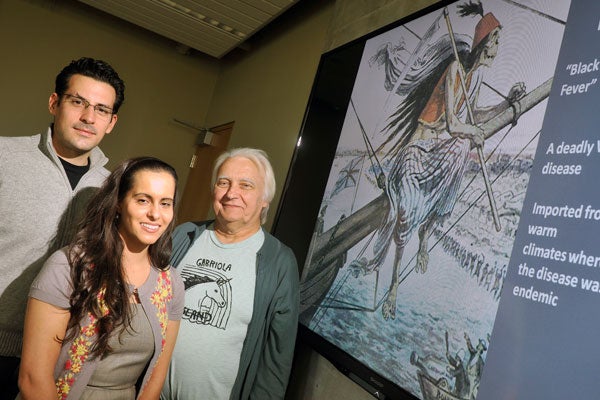
Crisis or catastrophe: understanding the difference
Published: November 27, 2013
New research from the University of Toronto Scarborough shows that when it comes to defining what makes an event catastrophic in terms of the death rate — whether it’s an outbreak of war, famine, disease and even extreme weather — the devil can be found in the demographic details.
"There is misconception about what makes an event a crisis or worse because there is no standard approach in determining normal mortality rates over a period of time,” says Larry Sawchuk, an associate professor in UTSC’s Department of Anthropology. “We wanted a technique that can be used to determine qualitatively whether an event fits a consistent pattern of mortality or if it’s something more excessive.”
Sawchuk, along with graduate student Lianne Tripp and UTSC statistics lecturer Sotirios Damouras — who developed the statistical technique used in the research — devised a method to differentiate a crisis from a catastrophe.
Using population data from 1825-2011 for Gibraltar, and from 1827-1993 for Malta, they were able to determine that only a limited number of events could be called a crisis or worse.
Mortality rates of the two former British colonies of Gibraltar and Malta were selected because the highly-trafficked port cities both shared a Mediterranean climate, overcrowded populations and deficiency in sanitary infrastructure and public hygiene, while still maintaining a tradition of reliable records-keeping over a long period of time.
According to their research, events that could appropriately be deemed a crisis include outbreaks of yellow fever and influenza in Gibraltar, as well as cholera outbreaks and casualties during the Second World War in both regions. According to their statistical scale, the 1918 influenza epidemic didn’t even qualify as a crisis in Malta; while there was a rise in mortality rates, it wasn’t nearly as high as other places in the world.
“That event was universally considered to be a devastating disease wherever it hit. But in Malta that wasn’t the case,” says Tripp. “By applying this method it may be shown that this epidemic and others were not as devastating in certain regions as once thought.”
The other benefit of the model is that it can be applied to events that occurred in different periods of time; all that is needed is population data and the recorded number of deaths, says Sawchuk.
They also found unusual events in which the mortality rate was lower than expected. In Malta, following the Second World War, health officials were baffled by stable mortality rates despite poor nutrition, overcrowding and the lack of sanitation caused by the war.
“Conditions were awful. Everything bad that could happen to a population to promote death took place in Malta during the war, but what happened was just the opposite and quite extraordinary,” says Sawchuk.
Their research found examples of what anthropologists call the harvesting effect, which occurs following a high mortality event and is characterized by a period of lower than normal mortality. This happens because those who are vulnerable, such as the sick, weak or elderly, die during the event. They discovered this took place following the 1865 cholera epidemic in Malta and Gibraltar, and the 1951 influenza outbreak in Gibraltar
“Mortality events are highly variable over time and space, so it’s important to have something objective to measure it,” says Sawchuk.
He points to the recent SARS and H1N1 outbreaks that many were calling a crisis. While they had significant economic consequences, from a demographic standpoint there was no evidence to support it was a crisis.
“If you are into crafting policy it’s important to know this because if an illness breaks out it’s very hard to predict the consequences,” says Sawchuk.
The research will be published in the upcoming edition of the American Journal of Physical Anthropology and is currently available online.
Don Campbell is a writer with the University of Toronto Scarborough.



